Book contents
- Frontmatter
- Contents
- List of figures
- List of tables
- Acknowledgments
- 1 Language-culture areas of south coast New Guinea
- Part 1 Grounding
- 1 Theoretical and ethnographic context
- 2 Historical background and regional configuration
- Part 2 Critique
- Part 3 Reconfiguration
- Appendix: evidence concerning Asmat homosexuality
- Notes
- List of references
- Index
- Cambridge Studies in Social and Cultural Anthropology
2 - Historical background and regional configuration
from Part 1 - Grounding
Published online by Cambridge University Press: 04 December 2009
- Frontmatter
- Contents
- List of figures
- List of tables
- Acknowledgments
- 1 Language-culture areas of south coast New Guinea
- Part 1 Grounding
- 1 Theoretical and ethnographic context
- 2 Historical background and regional configuration
- Part 2 Critique
- Part 3 Reconfiguration
- Appendix: evidence concerning Asmat homosexuality
- Notes
- List of references
- Index
- Cambridge Studies in Social and Cultural Anthropology
Summary
The Papuan or nonAustronesian language-culture areas of south New Guinea undulate along the coast for over 2,500 km, stretching from the Elema language-culture area in the east to the Asmat regions in the west (see figure 1, after Wurm and Hattori 1981). Most of this extensive coastline is an inaccessible maze of swamps, mangroves, muddy tidal flats, and sand bars, connected by innumerable shifting channels and occasional reefs. Buffeted by strong winds and surf, complex currents and tides, this murky boundary between land and sea was resistant to easy landing and contact by sailing ships, and even shallow-draft steamers of the twentieth century had difficulty navigating the everchanging coastline (e.g., Chalmers 1895; Butcher 1964; see Cook 1955:I:408–411). In many areas, when one finally arrived at coastal villages, they could even then be reached only on foot across an extensive area of mud or swamp.
Apart from difficulty of access, south coast New Guineans had a strong reputation among nineteenth-century Europeans as marauding headhunters and cannibals – as savages who would decapitate and eat visitors at will. Headhunting of enemies was in fact practiced along the entire nonAustronesian south coastal area, except by the Elema-speaking groups, and Europeans in the nineteenth century could easily be victimized by such violence once they left their boats.
- Type
- Chapter
- Information
- South Coast New Guinea CulturesHistory, Comparison, Dialectic, pp. 25 - 42Publisher: Cambridge University PressPrint publication year: 1993



